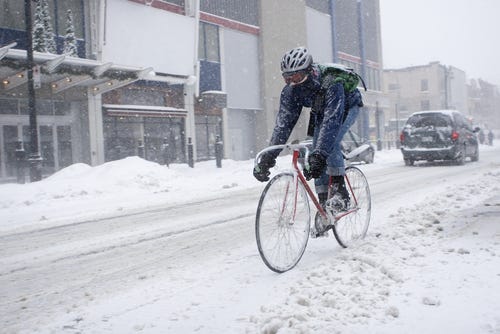Cycling during the summer and spring months is, of course, fairly easy. The sun’s usually out and the weather’s optimal, which makes any outdoor activity – cycling especially – a real breeze. But during the winter and fall months, things can get complicated – with ice, rain, sleet, snow, and chilly temperatures, it can be challenging to even head out for a simple walk around the block.

However, if you enjoy cycling, rest assured that it is possible to cycle year round, even during the coldest of winter months. Thanks to new and improved cycling gear and clothing, you can ride comfortably out in the snowy cold, as long as you dress properly and prep your bike in advance. Here are a few thoughts on how you can gear up for biking during the winter.
Wear Proper Clothing
Whenever we’re exposed to chilly temperatures, our bodies work hard to regulate our internal temperature. Therefore, failing to dress warmly enough can cause undue stress to your body, which can lead to potential injuries or illnesses. So, the most vital part of cycling outdoors is pretty straightforward – remember to dress warm enough. If you’re cycling during cold, but dry conditions, you may find that a soft fleece or down jacket, coupled with thick pants, a wool cap, and thick gloves will do just the trick. Or, if you’re cycling during a snow or rainstorm, you may find that wearing a waterproof shell along with a soft coat underneath – paired, of course, with waterproof or quick-dry pants, a long-sleeve shirt, moisture-wicking socks, and a beanie – can help you stay dry and warm.
Another important note when it comes to clothing is: layering. Even in chilly environments, it’s easy to start sweating and become overheated during your ride, but too much sweat can mean overexertion, dehydration, or even hypothermia. However, with the right layers, you can add or subtract clothing depending on how you feel. Also, consider wearing a quick-dry base layer, such as a polyester or nylon long-sleeve shirt, to add a little extra protection from the elements.
Wearing your helmet, especially if there’s ice, is a good idea. But remember to wear something under your helmet, like a cap or a beanie, to help you stay warm. It’s said we lose most of our body heat through the top of our head, so wearing a hat or beanie under the helmet can be beneficial. Exposed skin, like your face or hands, may become chapped due to wind chill, so you can wear a scarf or some gloves to keep you warm. Waterproof cycling shoes can also be a good idea.
Protect Your Bike
Just as it’s important to protect your body from the cold, it’s also important to protect your bike from the cold. Snow, ice, water, and mud will accumulate on your bike and its drive chain as you ride outdoors during wintery conditions. So, after each ride, you should make sure to keep your bike clean and oiled. A single-speed bike (which features minimal parts and therefore minimal maintenance) is usually best for outdoor winter riding. However, if you prefer to ride a multi-speed bike, you may have to invest in some internal geared hubs (the gears are sealed up from the elements), or you might want to purchase some winterized bike chains, which will stand up to rust a bit better than normal chains. Oil and fluids tend to coagulate during the cold, so you should constantly clean the gears, chains, and suspensions and reapply oil frequently.
There’s a reason why cars often have winterized tires – these specialized tires offer a better grip when the road is wet or icy. You can purchase mountain bike tires or thicker road tires to help with riding in the snow or ice. If you’re planning on riding during extremely icy conditions, some cycling companies actually make specialized ice or off road tires that are incredibly thick and feature embedded metal knobs for added traction. In fact, with these tires, it’s possible for you to even try trail riding during the winter!
Lastly, since it tends to get darker during the winter months, you might consider picking up a bike or helmet lamp to see more clearly during the later hours of the day.
Ride Safely
When riding during cold, icy, or wet conditions, remember to take it slow and easy. Riding too fast or taking corners too quickly might cause you to slide out, lose your balance, and fall. So simply ride proactively, remaining keenly aware of any potential pitfalls like icy patches or snow banks. Try to ride “loosely” too: tensing up may cause you to overcompensate when encountering a rough patch. Also, when you remain loose and flexible, you’ll increase your chances of avoiding an injury if you fall.
As long as you remember to wear the right clothing and to prepare your bike in advance, you should have no problem with cycling during the winter. In fact, winter biking can be a great way to explore the great outdoors during the snowy months – offering you a chance to see a local park, forest, or neighborhood from a unique perspective. Remember to ride safely!








